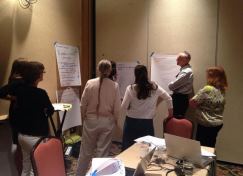
This post was written by Jess Meyer, a former member of our team.
When I checked in at the Keystone Resort a few weeks ago, the front desk clerk asked whose wedding I was there to celebrate. I laughed, and said I wasn’t here for that kind of engagement; I was there for the health system engagement. Specifically, I was there to join health system leaders from around the state and beyond at my first Colorado Health Symposium.
During the three-day event, there was plenty of excitement and interest in the idea of it, but what do we even mean by “engagement”? And how do we understand and incorporate it into our work at CCMU, given that it is generally messy and time-consuming? As I reflect on the presentations I heard and the discussions I had in Keystone, I see three keys to successful engagement that we need to be focused on:
First, we must engage with a more diverse group. Engagement in the health system is not a monologue, or even a dialogue. It is a clamor of voices from all directions, and an intentional effort to include voices that often go unheard. Dr. Lori Dorfman, of the Berkeley Media Studies Group, first outlined this notion for me, emphasizing that, “health is connected across institutions.” Then, Rachel MacCleery’s presentation about the work of the Urban Land Institute and their Building Healthy Places and Infrastructures initiatives further underscored this point. They bring together a dynamic group, from city planners to local artists to clinic directors, to develop innovative solutions and drive effective health systems change. They credit the success of the program to their engagement of a diverse range of community leaders. Lastly, Liz Baxter, of the Oregon Health Institute, who happens to be our annual luncheon keynote speaker, urged us all to think about who is not at the table in our current projects, and how we can include them going forward.
Second, we must embrace new forms of engagement. Dr. Brenda Zimmerman challenged us to do just this, stating, “We are stuck in the blood-letting paradigms of health,” and suggesting that we need to expand out of our old, comfortable methods. To this end, I learned from one discovery session about the new MyStrength app. It provides individualized behavioral health resources and tools, extending patient engagement beyond the clinic appointment without replacing it, reaching people where they are. I also took detailed notes from Robin Schepper, who briefly highlighted her work with the Let’s Move! Campaign, which includes elements like this music video, made in collaboration with Beyoncé.
Third, we must be more effective in how we engage. Liz Baxter emphasized the importance of informed engagement in her presentation. As health systems leaders, we should not “dumb down” the topics we are working on for a general audience, but should instead dedicate time to making them understandable. She also challenged us all to close the feedback loop. We must show the impact of engagement to those who have engaged, in order to encourage sustainable engagement partnerships.
Authentic engagement is certainly easier said than done. Fortunately, I get to see great examples of it in my work every day, especially through the Colorado Network of Health Alliances. These talented local leaders dedicate significant time and energy to bringing together the right people, in new and innovative ways, to make exceptional use of their limited resources. Together, they are driving collaborative change (PDF) in their local health systems. With the wise words of the Symposium presenters still fresh in our minds, I hope we, too, can leverage these three engagement strategies as a larger health care community, and make an impact on Colorado’s health system. I can’t wait to see it all in action!
Thank you to the Colorado Health Foundation for the opportunity to attend the Colorado Health Symposium as a Social Media Fellow.




